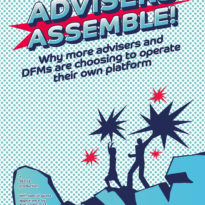Sponsored article
There’s never been a more important time to talk about Protection, says Tom Robinson, National Account Manager, Scottish Widows.
All financial advisers have clients who are self-employed or business owners. Irrespective of your specialism, there has never been a more important time to contact these clients to discuss protection.
As we entered 2020 one of the success stories for the UK economy had been the growth in the number of SMEs and self-employed business owners.
In fact of the 5.9 million businesses that operate in the UK, 99% of those are SMEs with fewer than 250 employees. Add to that the growing number of self-employed, which now exceeds five million people and accounts for 15.3% of the workforce.
We know through our research† that very few of these clients have adequate protection. This is often on their future ‘to do list’ as other priorities jump up the list and focus remains elsewhere. Moreover, we know that many clients will have raised equity on their family homes or have a lender take a second charge over the property to support investment into their business, compounding their vulnerability.
As the COVID-19 pandemic evolved business focus switched very quickly to whether they can trade, fundamentals like how they can pay their staff and what will the future look like became all consuming.
Unprecedented scale of support
The government’s reaction was swift with a number of measures for businesses, at the end of May £26.5 billion in loans and guarantees had been awarded to UK firms.
Businesses can apply for two forms of loan – Coronavirus Business Interruption Loan Scheme (CBILS) and Bounce Back Loans.
These have been popular with Businesses and as at 24 May the Treasury said £26.5bn has been lent via these schemes which includes 608,000 bounce back loans worth £18.49bn and 43,000 loans worth over £8bn through CBILS.**
Let’s look at what these finance options are:
Coronavirus Business Interruption Loan Scheme (CBILS)
This delivers commercial lending to business impacted by Coronavirus:
- Government-backed support for business with turnover of up to £45m
- Between £50k & £5m for up to 6 years with no fees or interest charged for the first 12 months
- 6-month Capital Repayment holiday at start of loan
- Loan must be less that 25% of 2019 turnover or less than 2 x annual wage bill.
Bounce back loans
The scheme has been designed to ensure that small firms who need vital cash injections to keep operating can get finance within days:
- Loans between £2k & £50k (max 25% T/O) with 12 month interest free period
- 6 year term – but can be repaid early – and no repayments required during first 12 months
- Simple 2-page application
- Fully automated
- Money available between 24 & 48 hours
From our own data at Lloyds Banking Group*, the average loan size for bounce back loans is around £30,000.
While it’s good news that the bounce back loans are so readily available on an automated efficient basis, it’s prudent to consider the flipside of that – £8.3 billion and counting of unprotected business debt is a staggering amount. This is in addition to what was already recognised as a huge protection gap in SME and the self-employed space.
Our research† shows just 5% of self-employed have critical illness cover, compared with 11% of those who are employed. So even with this support from the government these are tricky times for business owners, many of whom will have existing finance that may be secured on their family home.
A recent survey of small business showed that 4% have already ceased trading and two fifths fear they may have to close permanently.*** The term uncertainty has been used a lot in the past decade to cover a wide range of topics but for now many business will be feeling very uncertain about the future.
The future
As we come out of lockdown, the focus of business owners and the self-employed will be on adjusting to the new normal and planning for 2021. Therefore, this may not seem to be the logical time to be discussing protection needs but I’d argue that these conversations are now more important than ever at this time.
Taking the time to ask about how they are, helping them understand the risk for taking additional lending and how protection can be cost effective to mitigate further risks.
2020 has really shown that the unexpected can happen at any time. Help your clients to be better prepared as they rebuild their business. Find out more about our protection solutions.
*Source: Evening Standard, 5th May 2020
** HM Treasury coronavirus (COVID-19) business loan scheme statistics, 27th May 2020
*** Source: CityAm, 28th May 2020
† Scottish Widows research 2019






























